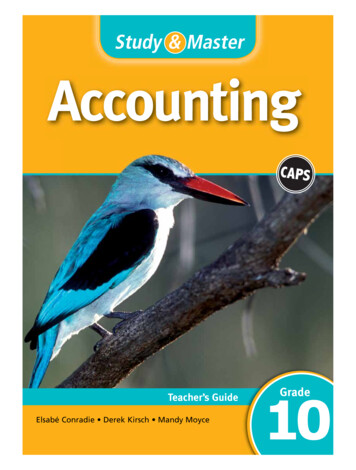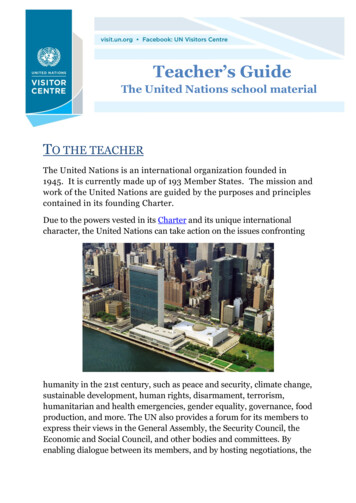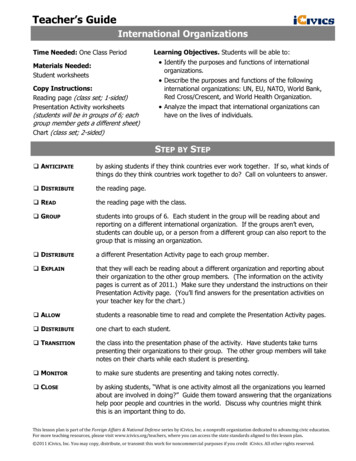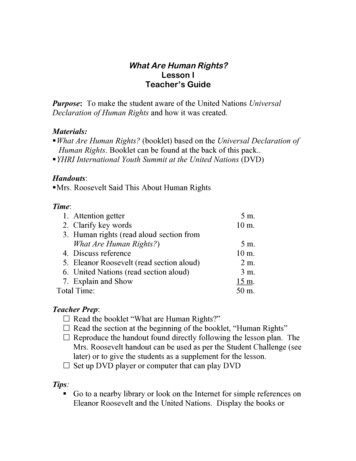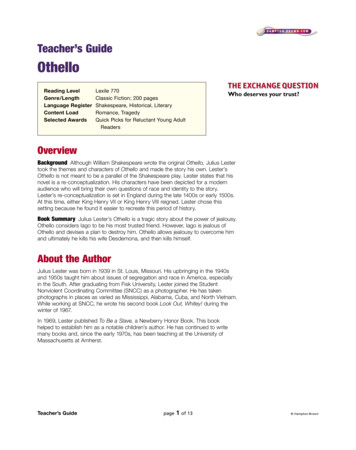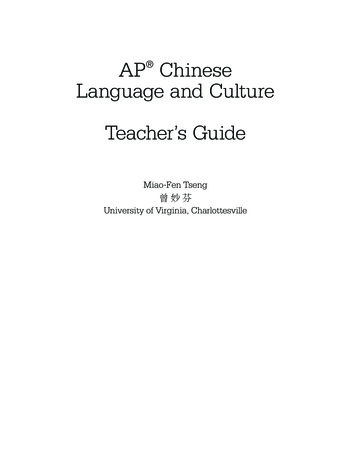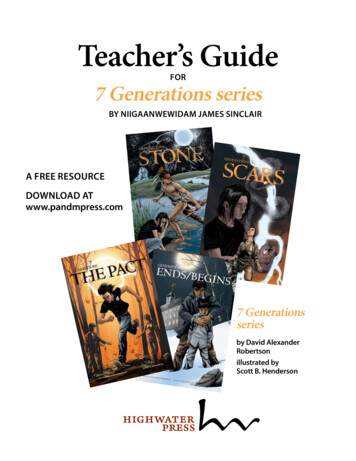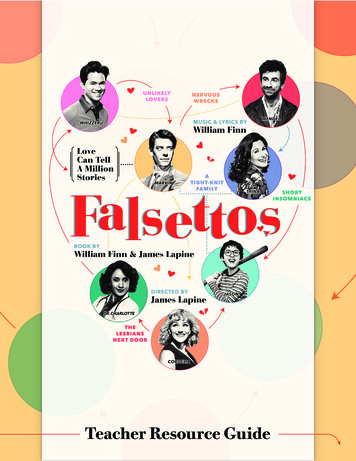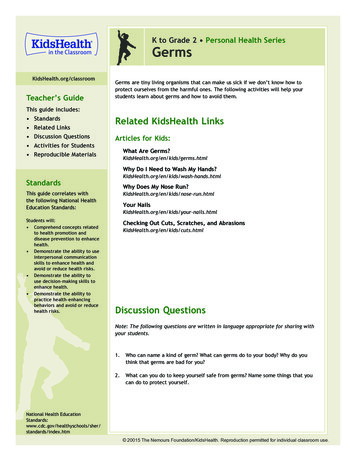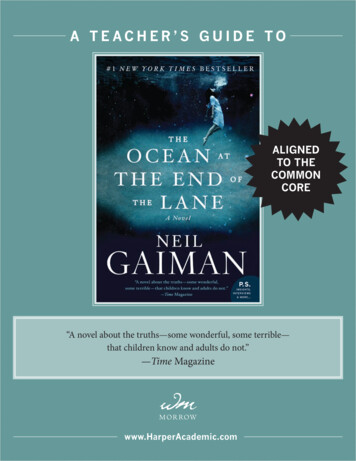
Transcription
A TEACHER’S GUIDE TOALIGNEDTO THECOMMONCORE“A novel about the truths—some wonderful, some terrible—that children know and adults do not.”—Time Magazinewww.HarperAcademic.com
A T E AC H ER ’ S G U I D E T O N EI L G A I M A N ’S T H E O C E A N AT T H E E N D O F T H E L A N E2Table of ContentsNote to Teachers3Guided Reading Questions4Prologue4Chapter One4Chapter Two5Chapter Three5Chapter Four6Chapter Five6Chapter Six7Chapter Seven7Chapter Eight8Chapter Nine8Chapter Ten9Chapter Eleven9Chapter Twelve10Chapter Thirteen10Chapter Fourteen11Chapter Fifteen11Epilogue12Writing and Discussion Prompts12Topics for Argumentation Essays or Debate12Topics for Informative Writing13Topics for Narrative Writing14Research Topics16More About Neil Gaiman16Books by Neil Gaiman17About This Guide’s Author17
A T E AC H ER ’ S G U I D E T O N EI L G A I M A N ’S T H E O C E A N AT T H E E N D O F T H E L A N E3Note to TeachersThe questions and activities in this teaching guide were written to support standards-based instruction. The Ocean atthe End of the Lane meets the standard for Range of Reading and Level of Text Complexity for grades 9-10. Its connections to folklore, mythology, and the hero journey make it an excellent anchor text for survey courses of world literature.CCSS.ELA-LITERACY.RL.9-10.10A complete list of the Common Core State Standards can be found at http://www.corestandards.org/the-standardsThis Teacher’s Guide is divided into three sections. The first, “Guided Reading Questions,” will help students with reading comprehension and appreciation. These questions can be used as a guide for annotating the text, journal responses, or discussion. Afocus on analysis of Gaiman’s use of figurative language is embedded within the questions. This section also includes a mentorpassage from each chapter. Teachers are encouraged to use these passages to discuss the grammar and style of Gaiman’s prose. Thesecond section, “Writing and Discussion Prompts,” consists of analytical writing and discussion prompts and is subdivided intogenres based on the writing standards. The third section, “Research Topics,” requires students to conduct and synthesize significant outside research on topics related to the novel.
A T E AC H ER ’ S G U I D E T O N EI L G A I M A N ’S T H E O C E A N AT T H E E N D O F T H E L A N E4Guided Reading QuestionsCCSS.ELA-LITERACY.W.9-10.10 Write routinely over extended time frames (time for research, reflection, and revision) andshorter time frames (a single sitting or a day or two) for a range of tasks, purposes, and audiences.PROLOGUEMentor Text: “I thought of turning around, then, as I drove down a wide street that had once been a flint lane beside a barley field,of turning back and leaving the past undisturbed”(3). CCSS.ELA-LITERACY.L.9-10.1.B1. Find descriptive and narrative details in the opening pages of the novel that reveal that the narrator has returned home toattend a funeral. CCSS.ELA-LITERACY.RL.9-10.12. Paraphrase the narrator’s description of his life found on page 4. What does he do for a living? Does he seem to be satisfiedwith the way his life has turned out? CCSS.ELA-LITERACY.RL.9-10.23. On page 5, the narrator uses the phrase “unlikely people” to describe the Hempstocks. What do you think this phrase impliesor suggests? How is the effect of the description “unlikely” different from other synonyms that have a similar denotation?CCSS.ELA-LITERACY.RL.9-10.44. What does the narrator’s memory of his father suggest about his father’s personality?(6) CCSS.ELA-LITERACY.RL.9-10.15. On page seven the narrator uses the image of cobwebs to describe his experience of the day’s events. What does this imagesuggest about the narrator’s past? CCSS.ELA-LITERACY.RL.9-10.46. What triggers the narrator’s memory of the events of the year he was seven? CCSS.ELA-LITERACY.RL.9-10.17. What is the difference between a sea and an ocean? Explain why it might be more logical to compare a pond to a sea. Whydo you think Lettie insisted on calling her pond an ocean instead? CCSS.ELA-LITERACY.RL.9-10.4CHAPTER ONEMentor Text: “The kitten was affectionate and interested and a good companion for someone whose seventh birthday had consisted of a table with iced biscuits and a blancmange and cake and fifteen empty folding chairs”(10). CCSS.ELA-LITERACY.L.9-10.31. What was traumatic about the narrator’s seventh birthday party? What does the decoration of his birthday cake suggestabout his personality? CCSS.ELA-LITERACY.RL.9-10.12. What details suggest that the narrator’s mother is sensitive to him? CCSS.ELA-LITERACY.RL.9-10.33. What do you think the narrator means when he says, “Books were safer than other people anyway”(9)? Do you agree ordisagree? Explain your answer. CCSS.ELA-LITERACY.RL.9-10.24. What gifts did the narrator receive for his seventh birthday? What do these gifts suggest about the narrator’s personality andinterests? CCSS.ELA-LITERACY.RL.9-10.15. Describe the relationship between the narrator and Fluffy. What happened to Fluffy? How did the narrator’s parents respondto the death of the kitten? CCSS.ELA-LITERACY.RL.9-10.16. What do you think the opal miner means when he gives the narrator a new cat and says, “Always pay my debts” (11)? Whatdetails in the description of the replacement cat suggest that the opal miner did not buy the new cat?CCSS.ELA-LITERACY.RL.9-10.37. In what specific ways is the new cat a foil for the narrator’s kitten? CCSS.ELA-LITERACY.RL.9-10.5
A T E AC H ER ’ S G U I D E T O N EI L G A I M A N ’S T H E O C E A N AT T H E E N D O F T H E L A N E5CHAPTER TWOMentor Text: “Nothing I had drunk had ever tasted like that before: rich and warm and perfectly happy in my mouth”(20).CCSS.ELA-LITERACY.L.9-10.2.B1. Explain the narrator’s statement that “I was not happy as a child, although from time to time I was content. I lived in booksmore than I lived anywhere else” (13). How does this statement help develop his character?CCSS.ELA-LITERACY.RL.9-10.32. Why did the narrator have to move into his sister’s bedroom? What did he like about his new living arrangement? What didhe dislike about it? CCSS.ELA-LITERACY.RL.9-10.13. Explain how Gaiman’s decision to include a flashback about the narrator visiting the Chamber of Horrors at the wax museumbefore revealing the suicide of the opal miner impacts a reader’s experience of the text. CCSS.ELA-LITERACY.RL.9-10.54. What specific descriptive details does Gaiman use to show the reader that the opal miner committed suicide?CCSS.ELA-LITERACY.RL.9-10.15. Who takes the narrator to the Hempstock Farm? Contrast the breakfast he receives from the Hempstocks with the breakfasthis father made him. CCSS.ELA-LITERACY.RL.9-10.16. What details suggest that the Hempstocks have supernatural abilities? CCSS.ELA-LITERACY.RL.9-10.17. Research the Domesday Book. Why would the fact that Hempstock Farm was mentioned in the book be significant?CCSS.ELA-LITERACY.L.9-10.48. What does Lettie find when she takes the narrator down to the pond? Why do you think she is troubled by this discovery?CCSS.ELA-LITERACY.RL.9-10.19. What does Lettie suggest will happen if the narrator puts the sixpence she gives him in his piggy bank? What details abouther suggestion could be an example of foreshadowing? CCSS.ELA-LITERACY.RL.9-10.5CHAPTER THREEMentor Text: “I was sad not to have won thousands of pounds (I already knew what I would buy with it. I would buy a place togo and be alone, like a Batcave, with a hidden entrance), but I was delighted to be in possession of a fortune beyond my previousimaginings” (26). CCSS.ELA-LITERACY.L.9-10.21. What events suggest that Lettie was correct in her suggestion that the sixpence would bring the narrator luck?CCSS.ELA-LITERACY.RL.9-10.12. Paraphrase the narrator’s nightmare. Why does he describe the silver shilling as “a bridge between my dream and the wakingworld”(28)? CCSS.ELA-LITERACY.RL.9-10.43. Who does the narrator tell about finding the shilling? How does she respond? CCSS.ELA-LITERACY.RL.9-10.14. What knowledge does Lettie have about the people that live on the lane? What do their struggles have in common?CCSS.ELA-LITERACY.RL.9-10.25. What does the narrator begin to suspect about Lettie? What question does he ask her in an attempt to confirm his suspicion?How does Lettie respond? CCSS.ELA-LITERACY.RL.9-10.16. What does Old Mrs. Hempstock notice after she examines the narrator’s shilling? What does the narrator think is causingmoney to suddenly appear? How do the Hempstocks respond to his suggestion? CCSS.ELA-LITERACY.RL.9-10.17. Explain the details in this chapter that seem to provide further evidence that the Hempstocks have supernatural abilities.What specific “powers” do they seem to have? Quote the passages from the text that support your answer.CCSS.ELA-LITERACY.RL.9-10.38. Based on the dialogue between Lettie, her mother, and her grandmother, what does Lettie want to do? Why do you think shewants to take the narrator with her? Who warns her against taking him? CCSS.ELA-LITERACY.RL.9-10.1
A T E AC H ER ’ S G U I D E T O N EI L G A I M A N ’S T H E O C E A N AT T H E E N D O F T H E L A N E6CHAPTER FOURMentor Text: “I saw the spring flowers; the omnipresent white and yellow daisies, the golden dandelions and do-you-like-butterbuttercups, and, late in the season, a lone bluebell in the shadows beneath the milk-churn table, still glistening with dew.”(36)CCSS.ELA-LITERACY.L.9-10.2.A1. Explain the steps that Lettie takes to lead the narrator into the magical dimension. CCSS.ELA-LITERACY.RL.9-10.12. What creature do Lettie and the narrator first encounter when they enter the magical part of the world? How do the details inits physical description match its name? CCSS.ELA-LITERACY.RL.9-10.43. What does the term “fleas” suggest about the creatures that Lettie and the narrator encounter on the borders of the Hempstock Farm? CCSS.ELA-LITERACY.RL.9-10.44. Analyze the imagery that Gaiman uses to describe the flapping creature. Based on the way it is described, what can you inferabout the creature’s personality? How does Lettie change when she encounters the flapping creature?CCSS.ELA-LITERACY.RL.9-10.45. According to the creature, why is she giving the people on the lane money? CCSS.ELA-LITERACY.RL.9-10.26. What is significant about the creature’s description of money as being “little tokens-of-work”? What do her comments suggestabout the values of human beings? (42) CCSS.ELA-LITERACY.RL.9-10.47. What do you think Lettie means when she tells the creature she is there to bind it? Why would the creature resist beingbound? CCSS.ELA-LITERACY.RL.9-10.18. What causes the narrator to let go of Lettie’s hand? What happens as a result of his letting go?CCSS.ELA-LITERACY.RL.9-10.19. What creature does the narrator pull out of the ground? Explain how this creature is connected to the death of the opal miner and the trauma of his unattended birthday party. CCSS.ELA-LITERACY.RL.9-10.2CHAPTER FIVEMentor Text: “I wondered, as I wondered so often when I was that age, who I was, and what exactly was looking at the face in themirror. If the face I was looking at wasn’t me, and I knew it wasn’t, because I would still be me whatever happened to my face, thenwhat was me? And what was watching?” (50) CCSS.ELA-LITERACY.L.9-10.1.B1. Describe the relationship between the narrator and his sister. What specific details suggest that the two were not close?CCSS.ELA-LITERACY.RL.9-10.32. Why does the narrator say he did not tell anyone about the hole in his foot? Do you find his explanation believable? Explainyour answer. CCSS.ELA-LITERACY.RL.9-10.33. Consider the narrator’s description of trying to pull the worm out of his foot. What details make the description particularlyeffective? What did he do to make the worm loosen its hold inside his foot? CCSS.ELA-LITERACY.RL.9-10.54. Why didn’t the narrator kill the worm? What did he do to it instead? What do you predict will happen as a result of his decision? CCSS.ELA-LITERACY.RL.9-10.3
A T E AC H ER ’ S G U I D E T O N EI L G A I M A N ’S T H E O C E A N AT T H E E N D O F T H E L A N E7CHAPTER SIXMentor Text: “An admission about myself: as a very small boy, perhaps three or four years old, I could be a monster” (51).CCSS.ELA-LITERACY.L.9-10.2.B1. In the first chapters of the book, the narrator frequently describes himself as being scared of things. Why do you think theworm in his foot did not scare him? (51) CCSS.ELA-LITERACY.RL.9-10.32. What do you think the narrator means when he says myths “weren’t adult stories and weren’t children’s stories. They justwere” (53). How do myths bridge both genres (adult and children’s literature)? CCSS.ELA-LITERACY.RL.9-10.13. What specific descriptive details connect Ursula Monkton to both the worm and the flapping creature?CCSS.ELA-LITERACY.RL.9-10.44. Why does the narrator refuse to eat food prepared by Ursula? How does this connect to traditional superstitions and folkloreabout the role of breaking bread with enemies? CCSS.ELA-LITERACY.RL.9-10.65. What do you think Gaiman means when he writes: “Adults follow paths. Children explore” (56). Do you agree with his statement? Explain your answer. CCSS.ELA-LITERACY.RL.9-10.46. How does Ursula threaten the narrator? What details in her threat confirm that she is the flapping creature?CCSS.ELA-LITERACY.RL.9-10.37. Cite specific textual evidence that suggests that there is a flirtatious tone to the conversation between Ursula and the narrator’s father. CCSS.ELA-LITERACY.RL.9-10.1CHAPTER SEVENMentor Text: “Now he pushed me down again, but fear of death gives us strength: my hands and teeth were clamped to his tie, andhe could not break his grip without hitting me” (73). CCSS.ELA-LITERACY.L.9-10.2.B1. Explain the possible connection between the book the narrator reads, Sandie Sees It Through, and the situation with UrsulaMonkton. CCSS.ELA-LITERACY.RL.9-10.52. Cite specific details that suggest that Ursula and the narrator’s father are becoming romantically involved with each other.Does the narrator seem to realize what is actually going on between Ursula and his father? CCSS.ELA-LITERACY.RL.9-10.13. On pages 66-67, the narrator gives details about his relationship with his father. Cite specific textual evidence that suggeststhat the relationship was abusive. CCSS.ELA-LITERACY.RL.9-10.34. Examine the argument between the narrator and his father. What is the narrator’s motivation for refusing to eat? What is thefather’s motivation for punishing his son? CCSS.ELA-LITERACY.RL.9-10.15. Explain how the narrator’s punishment mirrors what he did to the worm from his foot. What does this parallel suggest aboutUrsula’s influence over the narrator’s father? CCSS.ELA-LITERACY.RL.9-10.5
A T E AC H ER ’ S G U I D E T O N EI L G A I M A N ’S T H E O C E A N AT T H E E N D O F T H E L A N E8CHAPTER EIGHTMentor Text: “She was the storm, she was the lightning, she was the adult world with all its power and all its secrets and all itsfoolish casual cruelty”(86). CCSS.ELA-LITERACY.L.9-10.1.A1. What purpose does the narrative break on page 74 serve? Does it cast doubt on the narrator’s reliability or does it give himcredibility? Explain your answer. CCSS.ELA-LITERACY.RL.9-10.52. What comment does Ursula make that seems to confirm that she was responsible for the narrator’s punishment in the bathtub? CCSS.ELA-LITERACY.RL.9-10.13. Explain the narrator’s plan to escape. Why does he believe it is necessary to control his thoughts? What does he witness as heis leaving his house? Why is this disturbing? CCSS.ELA-LITERACY.RL.9-10.14. What do you think Ursula means when she says that the narrator is a door? CCSS.ELA-LITERACY.RL.9-10.45. Explain how the shift in Lettie’s diction as she interacts with Ursula helps emphasize the contrast between the children andthe adult world. CCSS.ELA-LITERACY.RL.9-10.26. Explain how this chapter is an example of magical realism. CCSS.ELA-LITERACY.RL.9-10.9CHAPTER NINEMentor Text: “There was still a monster in my house, and, in a fragment of time that had, perhaps, been snipped out of reality, myfather had pushed me down into the water of the bath and tried, perhaps, to drown me”(106). CCSS.ELA-LITERACY.L.9-10.1.B1. According to the Hempstocks, why aren’t any men living with them? CCSS.ELA-LITERACY.RL.9-10.12. What options do the Hempstocks come up with as a way to protect the narrator from his parents? What do these optionssuggest about the extent of their supernatural powers? CCSS.ELA-LITERACY.RL.9-10.13. How do the Hempstocks end up dealing with the narrator’s parents? What could be symbolic about their “snipping andstitching”? CCSS.ELA-LITERACY.RL.9-10.44. Examine Gaiman’s use of imagery in the passages dealing with the extraction of the foreign object in the narrator’s foot.Which sections do you find particularly effective or evocative? CCSS.ELA-LITERACY.RL.9-10.45. Old Mrs. Hempstock alludes to the historical figures of Oliver Cromwell and William II (Red Rufus) in her discussion of fleasand varmints. Research these two historical figures. Why do you think Gaiman chooses them to connect to the flappingcreature/Ursula? CCSS.ELA-LITERACY.RL.9-10.96. Do all of the narrator’s responses to the events in this section of the book seem believable? Explain your answer.CCSS.ELA-LITERACY.RL.9-10.3
A T E AC H ER ’ S G U I D E T O N EI L G A I M A N ’S T H E O C E A N AT T H E E N D O F T H E L A N E9CHAPTER TENMentor Text: “I believed in her, and that meant I would come to no harm while I was with her. I knew it in the way I knew thatgrass was green, that roses had sharp, woody thorns, that breakfast cereal was sweet”(115). CCSS.ELA-LITERACY.L.9-10.1.B1. What memory is the narrator reminded of when he sees Old Mrs. Hempstock in the moonlight? Why is this memory comforting? CCSS.ELA-LITERACY.RL.9-10.52. Based on the way that it is used in this section of the book, what do you think it means to “put a glamour” on something?(109) CCSS.ELA-LITERACY.L.9-10.4.A3. Do the Hempstocks view Ursula as an enemy? Cite specific textual evidence to support your answer.CCSS.ELA-LITERACY.RL.9-10.14. What objects does Lettie bring home from the bazaar? Do these objects seem particularly magical? What is she planning todo with them? CCSS.ELA-LITERACY.RL.9-10.15. According to Lettie, what are the three types of monsters? Do you agree with her categories?CCSS.ELA-LITERACY.RL.9-10.16. What secret about grow-ups does Lettie tell the narrator? CCSS.ELA-LITERACY.RL.9-10.17. What are the connotations of the word “varmint”? What do you think “varmints” are in the context of Gaiman’s story? Whywould Lettie be scared of them? CCSS.ELA-LITERACY.RL.9-10.48. Analyze the objects that Lettie places on the steps of the narrator’s house. Why do you think Gaiman includes these specificobjects? Do any of them seem particularly magical or symbolic? CCSS.ELA-LITERACY.RL.9-10.59. Analyze the interaction between Lettie and Ursula. What does Lettie want? What does Ursula want? How does Ursulareveal that she is dangerous? CCSS.ELA-LITERACY.RL.9-10.210. Based on context clues, what do you think “hunger birds” are? CCSS.ELA-LITERACY.L.9-10.4.ACHAPTER ELEVENMentor Text: “Her face was wrong, somehow: an accidental assemblage of features that simply put me in mind of a human face,like the knobbly gray whorls and lumps on the side of my beech tree, or the patterns in the wooden headboard of the bed at mygrandmother’s house, which, if I looked at them wrongly in the moonlight, showed me an old man with his mouth open wide, asif he were screaming” (124). CCSS.ELA-LITERACY.L.9-10.2.B1. Research the theory of wormholes and explain what a wormhole is. CCSS.ELA-LITERACY.W.9-10.92. Why does Gaiman switch Ursula’s dialogue into all capital letters? What emotion is he conveying?CCSS.ELA-LITERACY.RL.9-10.43. Why can’t Ursula use the wormhole to return to her home? CCSS.ELA-LITERACY.RL.9-10.14. Analyze the imagery used to describe the descent of the hunger birds. Which descriptions do you find particularly evocativeor effective? CCSS.ELA-LITERACY.RL.9-10.45. Why do the hunger birds refuse to leave? CCSS.ELA-LITERACY.RL.9-10.16. Research the folklore surrounding fairy rings. Based on your findings, why does Lettie tell the narrator to stay inside thefairy ring? CCSS.ELA-LITERACY.W.9-10.9
A T E AC H ER ’ S G U I D E T O N EI L G A I M A N ’S T H E O C E A N AT T H E E N D O F T H E L A N E10CHAPTER TWELVEMentor Text: “The sky was going gray and the world was losing depth and flattening into twilight. If the shadows were still thereI could no longer perceive them; or rather, the whole world had become shadows”(133). CCSS.ELA-LITERACY.L.9-10.2.A1. Describe the various temptations and tricks that are sent to lure the narrator out of the fairy ring.CCSS.ELA-LITERACY.RL.9-10.22. Read the “Pool of Tears” poem that the narrator quotes (the poem can be found in chapter three of Alice in Wonderland).How does the content of poem connect to the narrator’s experience? CCSS.ELA-LITERACY.RL.9-10.93. Explain the purpose of Gaiman’s use of italics in this sentence: “She was ripped to shreds by alien vulture-monsters and honestly I think you’re one of them or being controlled by them or something”(134). CCSS.ELA-LITERACY.RL.9-10.44. On page 135, the narrator quotes the song “A Nightmare” from Gilbert and Sullivan’s Iolanthe. Look up the lyrics to thissong. Can you find any elements of the song that could connect to the narrator’s memories and/or experiences?CCSS.ELA-LITERACY.RL.9-10.95. What gives the narrator the courage to stand up to his father? What does he say in response to his father’s threats? How doeshis father respond? Do you think that this was his “real” father or another trick? Explain your answer.CCSS.ELA-LITERACY.RL.9-10.36. How does the narrator test Lettie to make sure that she’s real? What is the result of his test?CCSS.ELA-LITERACY.RL.9-10.17. How does the voice in the dark attempt to lure the narrator? How does he respond to the voice? What do you think is thesource of the voice in the dark? CCSS.ELA-LITERACY.RL.9-10.2CHAPTER THIRTEENMentor Text: “I saw the world I had walked since my birth and I understood how fragile it was, that the reality I knew was a thinlayer of icing on a great dark birthday cake writing with grubs and nightmares and hunger”(143). CCSS.ELA-LITERACY.L.9-10.51. Explain the epiphany that the narrator has when he steps into Lettie’s ocean. What do you think the saying, “from Egg toRose” means? (143) CCSS.ELA-LITERACY.RL.9-10.22. When the narrator looks at Lettie, what does her true form look like? How do the connotations of images used to describeher substance (silk, ice, candles) differ from the connotations of the images used to describe Ursula’s true form?CCSS.ELA-LITERACY.RL.9-10.43. Explain the metaphor that the narrator uses to illustrate the concept of Dark Matter. CCSS.ELA-LITERACY.RL.9-10.44. What do you think the narrator means when he says: “if I looked inward I would see only infinite mirrors staring into myselffor eternity” (144)? CCSS.ELA-LITERACY.RL.9-10.45. Why do you think Lettie apologizes to the narrator? CCSS.ELA-LITERACY.RL.9-10.36. According to the narrator, what is Lettie’s ocean? (145) CCSS.ELA-LITERACY.RL.9-10.17. Why does Lettie say we have to give up the knowledge that we have before we are born? CCSS.ELA-LITERACY.RL.9-10.28. Explain the difference between the German words fressen and essen. What does this suggest about what the hunger birds doto creatures? CCSS.ELA-LITERACY.RL.9-10.49. Explain the simile that Ginnie Hempstock uses to describe “fleas” like Ursula. CCSS.ELA-LITERACY.RL.9-10.410. Why does the narrator think he might have to die? CCSS.ELA-LITERACY.RL.9-10.1
A T E AC H ER ’ S G U I D E T O N EI L G A I M A N ’S T H E O C E A N AT T H E E N D O F T H E L A N E11CHAPTER FOURTEENMentor Text: “Soon enough, there would be no world. My mother, my father, my sister, my house, my school friends, my town,my grandparents, London, the Natural History Museum, France, television, books, ancient Egypt—because of me, all these thingswould be gone, and there would be nothing in their place” (156). CCSS.ELA-LITERACY.L.9-10.1.B1. On page 152, the narrator lists all the things that are his fault. How is what happened “in the cold bath” different from theother things in his list? CCSS.ELA-LITERACY.RL.9-10.22. Why do the hunger birds want the narrator? Why can’t they take him from the Hempstocks? What do they begin to do as aresult of not being given the boy? CCSS.ELA-LITERACY.RL.9-10.13. Why does the narrator let go of Lettie’s hand? What happens as a result of his actions? CCSS.ELA-LITERACY.RL.9-10.14. Examine Gaiman’s use of italics on page 157. Why is this passage italicized? What added meaning does the use of italicsconvey? CCSS.ELA-LITERACY.RL.9-10.45. Who do you think the voice that speaks to the hunger birds belongs to? Explain your answer.CCSS.ELA-LITERACY.RL.9-10.26. Look up the lyrics to the nursery song “Girls and Boys Come Out to Play.” Why do you think the narrator begins hummingthis particular tune? How does the song connect to the events in the book? CCSS.ELA-LITERACY.RL.9-10.97. What does the narrator realize about Lettie’s actions? What do the Hempstocks do with her injured body? What is symbolicabout their actions? CCSS.ELA-LITERACY.RL.9-10.28. Read Ariel’s Song (“Full Fathom Five”) from Shakespeare’s play, The Tempest. Explain how and speculate as to why the narrator echoes some of Shakespeare’s imagery when he talks about Lettie. CCSS.ELA-LITERACY.RL.9-10.9CHAPTER FIFTEENMentor Text: “It’s hard enough being alive, trying to survive in the world and find your place in it, to do the things you need to doto get by, without wondering if the thing you just did, whatever it was, was worth someone having if not died, then having givenup her life”(167). CCSS.ELA-LITERACY.L.9-10.1.B1. On page 166, the narrator observes: “Ginnie looked like she was going to say something about the nature of truth.” If she hadspoken about truth, what do you think she would have said? CCSS.ELA-LITERACY.RL.9-10.22. Where does Ginnie Hempstock tell the narrator’s mother that Lettie has gone? What does the narrator say he remembersabout Lettie’s going away party? What explanation can you give for the narrator’s faint memory of an “alternate pattern ofevents” (168)? CCSS.ELA-LITERACY.RL.9-10.13. What does the narrator’s mother tell the children about Ursula Monkton? What does the narrator’s sister say she thoughtregarding the reason that Ursula left? CCSS.ELA-LITERACY.RL.9-10.14. What do the kitten-cat’s eyes suggest about its origins? Explain your answer. CCSS.ELA-LITERACY.RL.9-10.4
A T E AC H ER ’ S G U I D E T O N EI L G A I M A N ’S T H E O C E A N AT T H E E N D O F T H E L A N E12EPILOGUEMentor Text: “I thought about my heart, then; wondered if there was a cold fragment of a doorway inside it still, and if it was a giftor a curse if there was”(174). CCSS.ELA-LITERACY.L.9-10.2.A1. What do you think the narrator means when he responds to the old woman’s comment “I thought you’d probably fallen in,”by saying, “I sort of did”(172). CCSS.ELA-LITERACY.RL.9-10.12. What does the narrator find odd about the appearance of Ginnie and Old Mrs. Hempstock?CCSS.ELA-LITERACY.RL.9-10.13. According to Ginnie Hempstock, why does the narrator feel compelled to return to the pond from time to time?CCSS.ELA-LITERACY.RL.9-10.14. Explain the connotative and denotative meanings of Ginnie Hempstock’s observation that the narrator is “growing a newheart”(175). CCSS.ELA-LITERACY.RL.9-10.45. At the end of the book, what comment does the narrator make to Mrs. Hempstock that seems to indicate that he has alreadyforgotten everything he remembered while sitting by the pond? CCSS.ELA-LITERACY.RL.9-10.1Writing and Discussion PromptsTOPICS FOR ARGUMENTATION ESSAYS OR DEBATECCSS.ELA-LITERACY.W.9-10.1a-e Write arguments to support claims in an analysis of substantive topics or texts, usingvalid reasoning and relevant and sufficient evidence.CCSS.ELA-LITERACY.SL.9-10.1a-d Initiate and participate effectively in a range of collaborative discussions (one-on-one,in groups, and teacher-led) with diverse partners on grades 9–10 topics, texts, and issues, building on others’ ideas and expressing their own clearly and persuasively.1. Participate in a Socratic seminar that explores the following questions: Do you believe that the supernatural events actuallyhappened, or were they a part of the narrator’s imagination? Do you believe that it is possible to reliably narrate events fromone’s own childhood? Are there times when storytelling captures the emotional truth of an event more accurately than arealistic narration of facts? CCSS.ELA-LITERACY.RL.9 CCSS.ELA-LITERACY.SL.1a-d.2. On page 112, Lettie tells the narrator, “Sometimes monsters are things people should be scared of, but they aren’t.” What issomething that you think people should be more afraid of than they are? Compose a persuasive speech to convince yourclassmates that something or someone is more dangerous than they believe it to be. Using the flapping creature/UrsulaMonkton as your guide, include a description of what the thing you are describing would look like if it were an actual monster. CCSS.ELA-LITERACY.L.9-10.5 CCSS.ELA-LITERACY.L.9-10.3 CCSS.ELA-LITERACY.SL.9-10.43. When the Hempstocks snip out the narrator’s memory of being abused by his father, he pauses before destroying the scrapcontaining the memory and says, “I want to remember. Because it happened to me. And I’m still me”(100). If you had theability to “snip out” a painful memory from your own life, would you do it? Should we try to forget bad memories, or try toremember them? Explain your answer using both emotional and logical appeals. .54. At the end of the novel, the narrator reflects: “A story only matters, I suspect, to the extent that the people in the story change.But I was seven when all these things happe
What does he do for a living? Does he seem to be satisfied with the way his life has turned out? CCSS.ELA-LITERACY.RL.9-10.2 3. On page 5, the narrator uses the phrase “unlikely people” to describe the Hempstocks. What do you think this phrase implies or suggests? How is the effe
